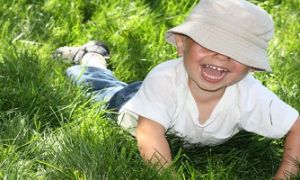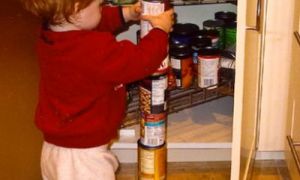Brain development is directly related to cognitive development which describes how a child’s intellect grows and includes thinking, learning and problem-solving skills. The following article provides information on the fundamental cognitive milestones of brain development (6 months to 2 years), nature or nurture in brain development, the importance of nutrition in brain development and activities to promote brain development.
The early years of a child’s life are crucial for later health and development. One of the main reasons for this is the tremendous rate at which the brain grows starting before birth and continuing into early childhood. Children are born ready to learn and have to develop a variety of skills to learn over many years. They depend on parents, family members, and other caregivers as their first teachers to develop the right skills to become independent and lead healthy and successful lives. How the brain grows is strongly affected by the child’s experiences with people and the world around them. Nurturing care for the mind is critical for brain growth.
Brain Development
The human brain begins forming very early in prenatal life (just three weeks after conception), but in many ways, brain development is a lifelong project. That is because the same events that shape the brain during development are also responsible for storing information—new skills and memories—throughout life. The major difference between brain development in a child versus an adult is a matter of degree: the brain is far more impressionable (neuroscientists use the term plastic) in early life than in maturity. This plasticity has both a positive and a negative side. On the positive side, it means that young children’s brains are more open to learning and enriching influences. On the negative side, it also means that young children’s brains are more vulnerable to developmental problems should their environment prove especially impoverished or un-nurturing.
Cognitive Development for Infants 0-12 months
Beginning at birth the construction of thought processes, such as memory, problem-solving, exploration of objects etc, is an important part of an infant’s cognitive development. An infant needs to interact with their environment in order to learn about it. By using their senses, infants educate themselves about the world around them.
By six months, a baby can
- Puts things in her mouth to explore them
- Reaches to grab a toy he wants
- Closes lips to show she doesn’t want more food
By one year, a toddler can
- Puts something in a container, like a block in a cup
- Looks for things when they are taken out of sight or when they see someone hide it, like a toy under a blanket
Cognitive Development for Babies 12-24 months
A baby’s cognitive development at this stage is very rapid and many changes take place over this time. They’re learning new things each day and spend their time observing others learn how to act. Babies become more curious as they begin to discover their surroundings and begin to engage in a wide variety of experiences.
By eighteen months, a toddler can
- Use things the right way, like a phone, cup, or book
- Stacks at least two small objects, like blocks
- Copies an adult doing chores, like sweeping with a broom
- Plays with toys in a simple way, like pushing a toy car
Cognitive Development for Toddlers 2-3-Year-Olds
Toddlers have a greater understanding of the world around them by this stage. Their cognitive development (also known as intellectual development and thinking skills) continues to increase during this period. The ability to learn new skills, understand of concepts, begins to make sense of current events, solve problems and use of memory steadily improves. Toddlers will begin to interpret the meanings of their experiences and they also have a vivid imagination.
After two years, a child can
- Holds something in one hand while using the other hand; for example, holding a container and taking the lid off
- Tries to use switches, knobs, or buttons on a toy
- Plays with more than one toy at the same time, like putting toy food on a toy plate
At around two years, children’s brain development goes through a major spurt. This is known as a critical period – another will happen during adolescence – the start of which is marked by a doubling of the number of synapses or the connections between brain cells called neurons. Two-year-olds have around double the number of synapses as adults. And since learning happens in these connections between brain cells, twice as many synapses enable the brain to learn faster than at any other time of life. The first critical period begins at around two years and continues till the child is approximately seven.
Jean Piaget - Cognitive Development discovered that all children’s cognitive development progressed through four stages, beginning in infancy and are completed by adolescence. Thinking becomes more and more complex as the child ages. Each stage of thinking causes the child to see the world in a different way.
Nature Or Nurture In Brain Development
Genes are in charge of the basic wiring scheme, which includes the formation of all cells (neurons) and general connections between different brain regions. Experience is responsible for fine-tuning those linkages and assisting each child in adapting to his specific environment (geographic, cultural, familial, school, peer group). Genes would indicate the number of phones and the primary trunk lines that connect one relay station to the next, using the analogy of building a phone network. The finer branches of this network—the connections between the relay station and each person's house or office—would be specified by experience.
Importance Of Nutrition and Brain Development
Children who are malnourished–not just picky eaters, but truly deprived of adequate calories and protein in their diet–do not grow adequately, either physically or mentally, during this period. Their brains are smaller than normal due to decreased dendritic growth, decreased myelination, and glia production (supporting cells in the brain which continue to form after birth and are responsible for producing myelin). Inadequate brain growth explains why malnourished children suffer from long-term behavioural and cognitive deficits, such as slower language and fine motor development, lower IQ, and poorer school performance.
The quality of a child's nutrition is crucial for brain development after birth. Breast milk contains the optimum combination of nutrients for brain development, as long as breast-fed infants are given iron supplements starting around six months of age. (Most infant cereals are iron-fortified, and breastfed newborns, whether or not their mothers are iron-deficient, require iron supplementation at six months.) In young children, iron insufficiency has been linked to cognitive abnormalities. Iron is vital for maintaining a sufficient number of oxygen-carrying red blood cells, which are required for brain growth. The iron-fortified formula should be given to bottle-fed newborns.
Due to the quick rate of myelination in early life, children require a high-fat diet (about 50% of total calories) until they are about two years old. Breast milk or formula should provide the majority of this fat to babies in their first year of life, and breastmilk remains a good source of liquid nourishment well into toddlerhood. Whole cow's milk, on the other hand, can be introduced after the first birthday and is a great source of fat and protein for toddlers in their second year. Children should begin moving to a more heart-healthy level of dietary fat (no more than 30% of total calories) after two years of age, including lower-fat cow's milk (1 or 2 per cent).
Experiences Change The Structure Of The Brain
Like computer circuits, neural circuits process information through the flow of electricity. Unlike computer circuits, however, the circuits in our brains are not fixed structures. Every experience–whether it is seeing one’s first rainbow, riding a bicycle, reading a book, or sharing a joke–excites certain neural circuits and leaves others inactive. Those that are consistently turned on overtime will be strengthened, while those that are rarely excited may be dropped away. Or, as neuroscientists sometimes say, “Cells that fire together, wire together.” The elimination of unused neural circuits, also referred to as “pruning,” may sound harsh, but it is generally a good thing. It streamlines children’s neural processing, making the remaining circuits work more quickly and efficiently. Without synaptic pruning, children wouldn’t be able to walk, talk, or even see properly.
Neural circuits, like computer circuits, use electricity to process information. The circuits in human brains, unlike computer circuits, are not fixed structures. Every event, whether it's seeing one's first rainbow, riding a bike, reading a book, or sharing a joke, activates some neuronal circuits while inactivating others. Those who are continuously turned on during the day will be strengthened, while those who are rarely excited may be dropped. "Cells that fire together, wire together," as neuroscientists put it. Pruning, or the removal of unneeded neuronal circuits, may appear harsh, yet it is often beneficial. It improves the speed and efficiency of children's neural processing by streamlining their neural processing. Children would be unable to walk without synaptic pruning.
Activities To Foster Brain Development
Here are a variety of children's activities the first critical period can be used to foster brain development.
-
Make opportunities for free, active play. As children play, they develop not just gross motor skills involved in walking, running, jumping, coordination and fine motor skills involved in writing, manipulating small tools, and detailed handwork but executive functioning and creative intelligence. It is important to make time for unstructured play and self-driven play since what kids enjoy doing, they will do more willingly.
-
Expose them to a wide variety of experiences to promote the rapid building of synapses. Use books, stories, songs, excursions, experiments, and demonstrations to engage children in music, reading, sports, math, art, science, and languages.
-
Keep them safe. Children grow and learn best in a secure environment where they are protected from neglect and from extreme or chronic stress. Understand their needs and respond sensitively to protect children’s brains from stress
-
Keep them healthy. To learn and grow appropriately, a child’s brain has to be healthy and protected from diseases and other risks. Ideally, such care should start even before the baby is born. After birth, they should be given necessary childhood vaccinations, protected from head injuries and have access to the right care and nutrition.
References:
- Early Brain Development and Health, CDC
- FAQ Brain Development, Zero to Three




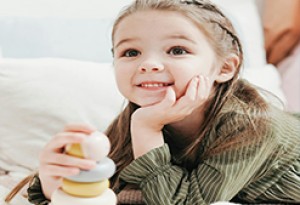
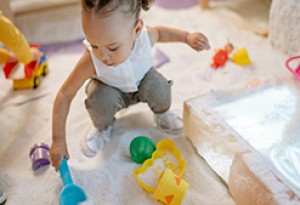
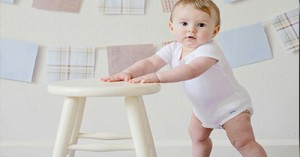
 Toddlers have a greater understanding of the world around them by this stage. Their cognitive development (also known as intellectual development and thinking skills) continues
Toddlers have a greater understanding of the world around them by this stage. Their cognitive development (also known as intellectual development and thinking skills) continues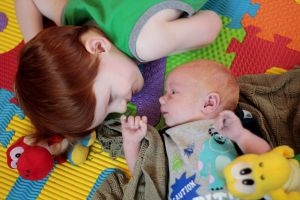 Infants begin to develop trust when parents begin to fulfil their needs. Such as changing an infant's nappy when needed, feeding on request and holding
Infants begin to develop trust when parents begin to fulfil their needs. Such as changing an infant's nappy when needed, feeding on request and holding Beginning at birth the construction of thought processes, such as memory, problem solving, exploration of objects etc, is an important part of an infant’s cognitive
Beginning at birth the construction of thought processes, such as memory, problem solving, exploration of objects etc, is an important part of an infant’s cognitive Toddlers want to do more on their own and do not like it when you begin to establish limits on their behaviour. Tantrums can become
Toddlers want to do more on their own and do not like it when you begin to establish limits on their behaviour. Tantrums can become Your preschooler is now able to focus their attention more accurately and is less influenced by distractions. The intensity of questions increase as your child
Your preschooler is now able to focus their attention more accurately and is less influenced by distractions. The intensity of questions increase as your child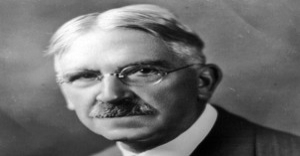 John Dewey is often seen as the proponent of learning by doing – rather than learning by passively receiving. He believed that each child was active,
John Dewey is often seen as the proponent of learning by doing – rather than learning by passively receiving. He believed that each child was active, Toddler advance and gains new skills in Gross Motor Development milestones achieved throughout earlier years. Co-ordination and challenges that could not be performed before such
Toddler advance and gains new skills in Gross Motor Development milestones achieved throughout earlier years. Co-ordination and challenges that could not be performed before such Erik Erikson developed a psychosocial theory to understand how we each develop our identities through eight stages of psychosocial development from infancy to adulthood. The
Erik Erikson developed a psychosocial theory to understand how we each develop our identities through eight stages of psychosocial development from infancy to adulthood. The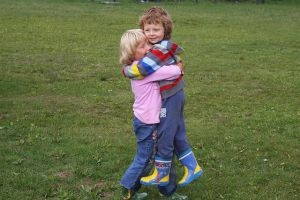 At this point preschoolers begin to interact effectively with others. Play becomes more innovative and organized and “boyfriend” or “girlfriend” begins to emerge. Preschoolers have
At this point preschoolers begin to interact effectively with others. Play becomes more innovative and organized and “boyfriend” or “girlfriend” begins to emerge. Preschoolers have From now, babies begin to identify and respond to their own feelings, understanding other's feelings & needs and interact positively with others. A baby's social and
From now, babies begin to identify and respond to their own feelings, understanding other's feelings & needs and interact positively with others. A baby's social and